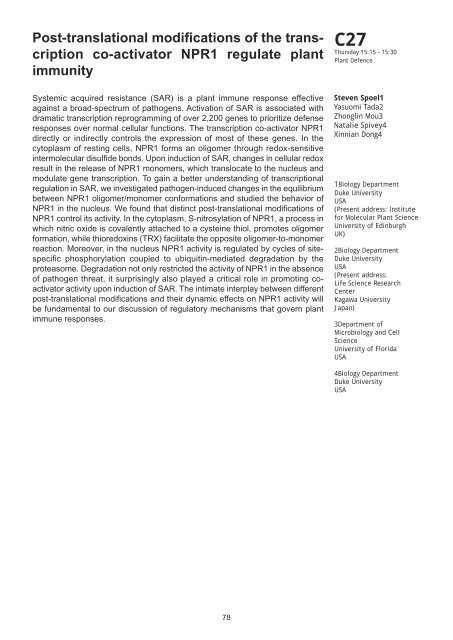Edinburgh, Scotland, United Kingdom - TAIR
Edinburgh, Scotland, United Kingdom - TAIR
Edinburgh, Scotland, United Kingdom - TAIR
Create successful ePaper yourself
Turn your PDF publications into a flip-book with our unique Google optimized e-Paper software.
Post-translational modifications of the transcription<br />
co-activator NPR1 regulate plant<br />
immunity<br />
Systemic acquired resistance (SAR) is a plant immune response effective<br />
against a broad-spectrum of pathogens. Activation of SAR is associated with<br />
dramatic transcription reprogramming of over 2,200 genes to prioritize defense<br />
responses over normal cellular functions. The transcription co-activator NPR1<br />
directly or indirectly controls the expression of most of these genes. In the<br />
cytoplasm of resting cells, NPR1 forms an oligomer through redox-sensitive<br />
intermolecular disulfide bonds. Upon induction of SAR, changes in cellular redox<br />
result in the release of NPR1 monomers, which translocate to the nucleus and<br />
modulate gene transcription. To gain a better understanding of transcriptional<br />
regulation in SAR, we investigated pathogen-induced changes in the equilibrium<br />
between NPR1 oligomer/monomer conformations and studied the behavior of<br />
NPR1 in the nucleus. We found that distinct post-translational modifications of<br />
NPR1 control its activity. In the cytoplasm, S-nitrosylation of NPR1, a process in<br />
which nitric oxide is covalently attached to a cysteine thiol, promotes oligomer<br />
formation, while thioredoxins (TRX) facilitate the opposite oligomer-to-monomer<br />
reaction. Moreover, in the nucleus NPR1 activity is regulated by cycles of sitespecific<br />
phosphorylation coupled to ubiquitin-mediated degradation by the<br />
proteasome. Degradation not only restricted the activity of NPR1 in the absence<br />
of pathogen threat, it surprisingly also played a critical role in promoting coactivator<br />
activity upon induction of SAR. The intimate interplay between different<br />
post-translational modifications and their dynamic effects on NPR1 activity will<br />
be fundamental to our discussion of regulatory mechanisms that govern plant<br />
immune responses.<br />
78<br />
C27<br />
Thursday 15:15 - 15:30<br />
Plant Defence<br />
Steven Spoel1<br />
Yasuomi Tada2<br />
Zhonglin Mou3<br />
Natalie Spivey4<br />
Xinnian Dong4<br />
1Biology Department<br />
Duke University<br />
USA<br />
(Present address: Institute<br />
for Molecular Plant Science<br />
University of <strong>Edinburgh</strong><br />
UK)<br />
2Biology Department<br />
Duke University<br />
USA<br />
(Present address:<br />
Life Science Research<br />
Center<br />
Kagawa University<br />
Japan)<br />
3Department of<br />
Microbiology and Cell<br />
Science<br />
University of Florida<br />
USA<br />
4Biology Department<br />
Duke University<br />
USA




